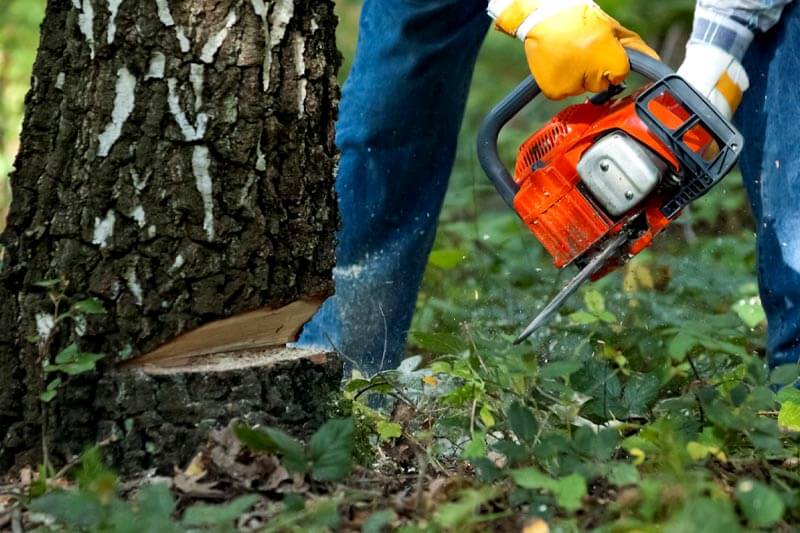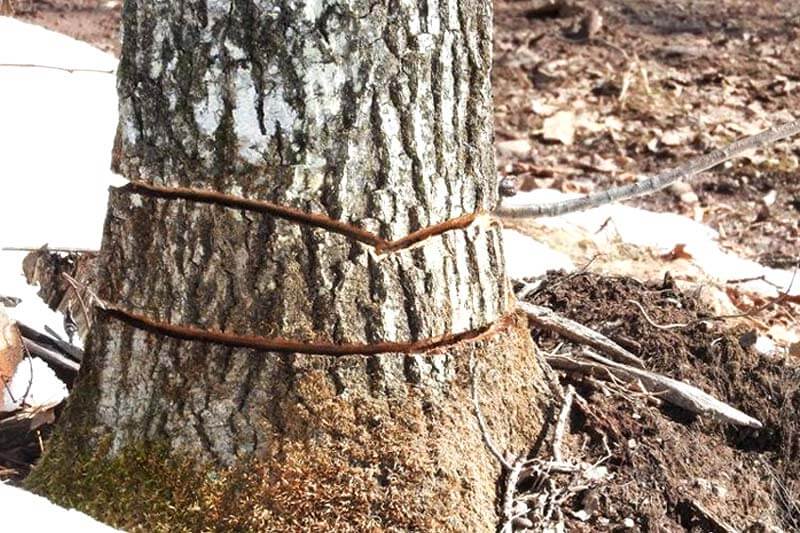There are many legitimate reasons for killing a tree such as causing foundation issues to your home, an invasive species, or becoming an immediate hazard to safety.
The fastest way to kill a tree is by complete physical removal by a tree service. If you are looking to just kill the tree without actually removing it, you are best ring-barking the tree using roundup to poison it.
There are a bunch of ways to effectively kill a tree which we go through below. If you want to kill a tree without anyone knowing, go here.

Killing a tree with Epson salt
Using salt is an effective way to kill a tree. It can take a lot of salt and it will contaminate the soil so you won’t be able to plant anything there for quite a while. – and there are many good reasons – salt can be the best solution, especially if you’re not comfortable with herbicides.
The sodium in salt will prevent a tree’s flow of potassium and magnesium, both of which are vital ingredients in the making of chlorophyll. The lack of chlorophyll will eventually kill the tree. You can simply make a line of salt around the tree, and it will die.
However, almost everything around the tree will die as well if you spray the salt around the tree. To avoid this, you need to take measures to concentrate the salt around the tree to ensure you minimize the destruction of other plants.
Steps to kill a tree with salt
- Step 1: Drill four to six 1/2-inch holes around the tree. Position the holes diagonally in the tree. Start drilling approximately five inches up from the base of the tree, and angle the drill bit in a downward position. Drill at least 3 inches deep.
- Step 2: Pour 3 cups of water into a container, then add 6 cups of salt. Mix the two together. You can change the amount of solution you mix by maintaining a ratio of one part water to two parts salt.
- Step 3: Pour the solution into the holes you drilled into the tree. Monitor the solution. When it dissipates, refill the holes with more. Continue doing this weekly until the foliage on the tree turns brown and dies.
Killing a tree with vinegar
If you don’t want to use toxic chemicals to kill your trees fast, another option is to use Vinegar. Vinegar is a homemade alternative that is both organic and effective, although multiple applications are necessary to kill the roots.
Select a warm, dry day and fill a spray bottle with undiluted white vinegar. Spray vinegar to thoroughly coat the leaves of shoots growing back from the tree roots and stump. This destroys the leafy top growth that is supplying the roots with food and eventually kills the remaining tree roots.
Killing a tree with diesel
Wondering about a harmless way to kill the toughest of trees? Try diesel.
Diesel mixed with sugar will kill a large tree and even the root. Using an old diesel-only solution will not do a perfect job, but there’s hardly a tree that will survive the diesel-sugar treatment.
To kill a tree with diesel, use an equal part mixture of sugar and diesel. Get a one-gallon gas can and fill it with a half-gallon of diesel fuel. Then fill the rest with sugar and shake until sugar dissolves. For just a few bucks you will have a gallon of the best tree killer around.
Will diesel kill tree roots?
Diesel will kill tree roots and then the whole tree will die. To kill tree roots with diesel just uncover live roots and drill a hole into them and pour the diesel-sugar mixture into it. You should avoid spilling the mixture onto the ground because it can get into groundwater.
Will diesel kill tree stumps?
Diesel will kill tree stumps. However, you need to expose the live part of the stump before treating it with diesel.
You can do this by cutting each sucker branch and treating each one by painting diesel fuel on it or you can the stump below where the suckers are coming out and paint diesel on the stump.
Killing a tree with bleach
Bleach is one of the household items that can be used in killing trees. However, it is not as effective as herbicides designed mainly to kill trees. This is because bleach is systemic in nature and does not easily get absorbed as herbicides. Due to the low absorption, enough of it is not transported through the tree to cause its death. Bleach only affects the most vulnerable areas on which it is applied such as the leaves and the exposed part of the branches.
Meanwhile, if you’re using bleach on small trees or delicate plants that require a lot of care, then it may end up killing such if used in large doses.
Girdling
This process is also known as ring barking or ring-barking. It involves the removal/peeling of a ring of bark and the phloem layer from a tree. A tree that gets girdled dies gradually over a period of time.

How girdling works
We all know that the central part of the tree trunk (wooden part) is involved in taking the nutrients and water up to the leaves. The leaves then get exposed to the sun and mix in carbon dioxide to make sugar and other reduced carbon compounds.
The outer part of the trunk – the bark and the phloem layer – also has a solid function that sustains growth and function. They are responsible for transporting the nutrients made by the leaves back to the root. That is basically food to sustain the growth and function of the roots. If that doesn’t reach the roots, the roots don’t receive what is required to grow and perform their functions.
Girdling cuts off the down-flow of food and as a result, the root dies as well as the whole tree.
If you’re thinking of a faster method to kill your tree, girdling may not be appropriate as it is a slow process.
Killing trees with herbicides
Herbicides can be very effective for killing trees, especially zombie trees that have been cut down but continue to grow back. The chemicals in the herbicide will destroy the sap and other living parts of the tree, thereby stopping nutrient transport.
This will eventually lead to the death of the tree. While using this method, it’s important you follow all Federal, state, and local laws and regulations regarding the use of herbicides.
Different methods of killing the tree with herbicides:
- Spray the bottom 12 inches of the bark of the tree with a tree-killing herbicide, such as Tordon.
- Make a series of cuts in the bark around the circumference of the tree and apply a strong herbicide, like Roundup or Tordon.
- Remove a 4–8-inch wide ring of bark around the tree. Apply herbicide to ensure tree roots are killed.
- Drill 1–2 inch deep holes around the circumference of the tree and inject herbicide.
- If the tree is less than 15 feet tall, spray the leaves with foliar herbicide, such as Roundup.
Additional herbicide application methods
Stem injections
This is another method of herbicide treatment. It requires specialized equipment to inject herbicide into the tree every 2 to 6 inches around the tree’s circumference.
Foliar herbicide applications
This is appropriate for small or young trees no taller than about 15 feet that are not close to desirable vegetation. Foliage application involves thoroughly spraying the tree’s leaves with herbicide when the tree is not under drought stress and when the weather is mild.
Where a large number of unwanted trees and no desirable plants are present, soil treatment can effectively kill many trees in a small area. Soil treatment involves applying herbicides to the soil surface and irrigating the area, or allowing rainfall to move the chemical to the root zone,
Precautions in Herbicide treatment of a tree
- It’s important to apply herbicide at the proper concentration recommended by the manufacturer for the specific application method. Too low a concentration will merely injure the tree, not kill it, while a highly strong solution can kill tissue near the application site too quickly, not giving the chemical a chance to spread throughout the tree and its root system.
- It’s important to seek professional opinions on choosing the best herbicide appropriate for each tree species and application method.
- Ensure you wear protective gear before spraying the herbicide and avoid having the herbicide get in touch with your skin.
- Don’t apply during windy conditions or if rain is expected. Keep children and pets away from the treated area until the product dries.
- Wash hands thoroughly before eating, drinking, using tobacco products, or going to the bathroom.
- You should store herbicides in a well-ventilated, cool, dry area where food and drinks are never stored or prepared. Most pesticides should not be stored for any length of time below 40°F. The floor should be concrete or lined with plastic or other impermeable material to prevent leaks from reaching the soil.
- It’s important to use extreme caution when mixing chemicals to avoid spillage and dermal exposure.
- Make sure to follow all federal, state, and local regulations regarding herbicide use. You must read and follow product labels. It is a violation of federal law to use an herbicide in a manner inconsistent with its label.
What is the best time of the year to kill a tree with herbicides?
The best time to kill standing trees is in fall. This is because in fall the sap flows downward from the branches to the roots. This means any chemical herbicide applied in the fall will naturally be carried to the roots and kill the entire tree.
What chemicals will completely kill a tree?
It is easy to kill every part of a tree, but not the root. The roots can continue to cause problems for weeks or even months and this can make it difficult to install fencing or dig holes for new plants. It can also interfere with nutrient absorption, protrude through the ground, and present a walking hazard.
Unseen root growth can invade sewer lines, damaging your plumbing and resulting in expensive repairs. In order to avoid all these dangers posed by tree roots, you may want to consider killing the root with chemicals. The choice of chemical to use depends on the application method and specific need.
Small trees
For small trees up to about 15 feet tall, simple foliar spraying can be effective at killing the tree and its roots. Examples of chemicals used in foliar sprays are those that are readily absorbed such as Triclopyr, 2,4-D, picloram, and dicamba in spring and early summer, Imazapyr for midsummer, and glyphosate for late summer and early fall.
Medium to large trees
For medium-sized and larger trees with a diameter of more than 5 inches, it is better to use herbicides that will reach directly into the plant’s vascular system to access the roots. Chemicals used in these herbicides include triclopyr, picloram, 2,4-D, and dichlorprop.
For surface application, herbicides applied directly to the soil surface are carried down into the root system with rainfall or watering. The chemicals kill the roots when they come into direct contact with them. Chemicals that follow this mechanism are bromacil, hexazinone, and tebuthiuron.
Want to remove a tree fast?
The fastest and easiest way is to get 3 Estimates from the most affordable tree services near you by using this FREE service.
GoTreeQuotes.com quickly matches you with the 3 tree surgeons voted #1 by previous users in your area.
- Scroll up to the top of the page and enter your ZIP Code in the blue form at the top of the page.
- Give us a few details about your tree job plus some contact information.
- Your tree details are forwarded to the closest three tree services all voted best priced who will also price your tree job.












